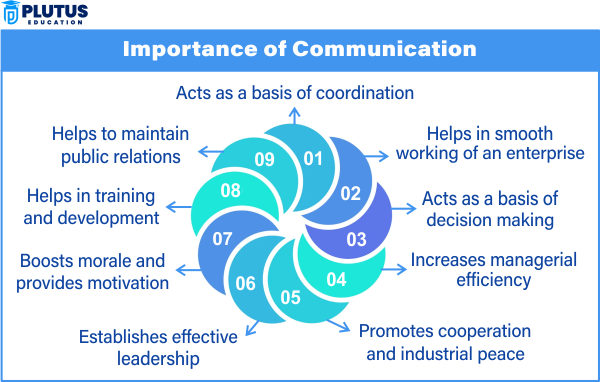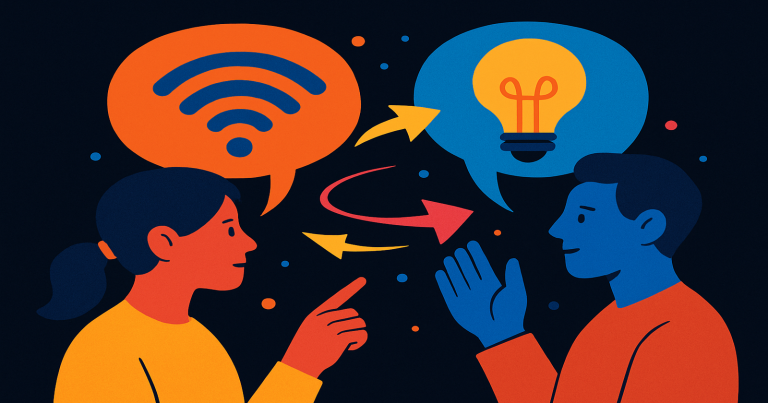Communication serves as the lifeblood of human interaction, after all. An individual communicates to express ideas, share information, settle misunderstandings, and create bonds. Communication with some effectiveness assures collaboration, productivity, and individual growth. In business, particularly, good communication ensures team alignment, leadership support, and a direct impact on success. This article aims to engage the reader in understanding the meaning of communication and its processes, forms, importance, and obstacles that can hinder it.
What is Communication?
Communication is much more than talking or writing; it is the building of ordinary meaning for those communicating. Communication is sending messages through spoken words, written texts, gestures, images, or sounds so that the other party will interpret and respond meaningfully.
Definition and Basic Function
The basic definition of communication requires sending an idea, thought, or feeling from a sender to a receiver. This has led to shared understanding imperative in every sphere of life: cooperation and mutual respect.
Channels of Communication
Communication uses many modes: spoken conversation, written emails versus body language, videos, versus social network postings. All of these media simultaneously offer specific advantages while fitting in various situations.
Sender and Receiver Function
The sender initiates communication, and the receiver interprets and responds to it. Good communication occurs when the receiver understands what the sender intended.
Importance in Everyday Life
From ordering food to sealing deals to encouraging a friend, communication comes into play in everything we do. The success or failure of communication squashes whatever outcome on the very trivial and most serious matters.
Symbolization in Communication
Language, gestures, and pictures often carry symbolic meanings much greater than their literal interpretation. Understanding these adds richness to our communication and helps avoid miscommunication.
Importance of Communication in Personal and Professional Life
Communication occupies a central role in all walks of life. In nurturing personal contexts or pushing towards a professional goal, communication has been treasured to develop clarity in expression and listening.

A Shared Understanding
Clear and precise communication imparts the same meaning to all those taking part. Diminishing such disparities promotes joint action while engaging with teams and resolving interpersonal relations.
Stronger Relationship
The two open Communication methods nurture high levels of trust and emotional closeness. Relationships will form, strengthen empathy, and encourage complete and free discussion, which ultimately forms the basis of meaningful relationships.
Conflict Resolution
Communication counts when it communicates differences. Open communication allows individuals to discuss their concerns, appreciate differing perspectives, and jointly develop a solution for resolution.
Personal Goal and Organizational Goal Attainment
Clearly and accurately communicating expectations, responsibilities, and feedback keeps everyone on the same page and motivated to achieve personal success and organizational effectiveness.
Encouraging Personal Growth
The more people develop their communication skills, the more confident and self-aware they become. The clear expression of ideas builds self-confidence and helps them in their academics and learning at work.
Better Decision-Making
Open Communication allows for fully informed decisions to be made. It ensures stakeholders can weigh options, assess risks, and collectively commit to an action plan.
Categories of Communication
There are many forms of communication, each suited to communication texts. The various forms of communication empower an individual to communicate most appropriately when interacting under such exceptional circumstances.
Verbal Communication
Verbal communication refers to using communication language to convey messages. It includes conversation, speeches, written documentation, and online chats with an insight into the clarity of language, controlling the tonality of words, and precise choice of words.
Non-Verbal Communication
Any gestures of body language, including facial expressions, posture, and eye contact. Often, these messages deliver far more emotional charge or intention than mere spoken words ever could.
Written Communication
Written communication includes memos, communications, and other texts. Its strengths include being transparent, explicit, and valuable in formal contexts. In such a mode of communication, much care must be given to the communication structure and grammar.
Visual Communication
Visual communication includes graphs, communication, and presentations that help simplify complex information. They support verbal/written messages in terms of enhancing understanding.
Digital Communication
Digital communication happens on social networking platforms, over video calls, and through instant messaging apps. These tools allow two or more people to interact in real time, but they demand a measure of digital etiquette and precision.
The Communication Process
The communication process is a systematic movement from the idea to the message split at various nodes for interpretation by the target receiver. Knowing the communication process is essential for ensuring effective and meaningful communication.
Message Sent
Senders send communication; initiators initiate communication by thinking of the idea or information they need to relay. This stage requires a straightforward thought process and a good understanding.
Message Encoding
The sender encodes the message into words, visuals, or actions. This is where the idea is moulded into some format that others understand.
Choosing the Channel
Transmission will occur through the selected channels: speaking, emailing, texting, or body language. Choosing the proper means requires matching it to fit with context and audience.
Receiving and Decoding
From this point forward, the recipient decodes the message’s meaning, considering their perceptions, experiences, and cultural context. Miscommunication at this juncture is possible if the messenger is unclear or irrelevant.
Feedback
This feedback thus helps close the circle of communication. It gives the communication on whether or not the message was understood in the intended manner. In the case that there is deviance from the desired meaning of the message, this allows the sender an opportunity to clarify for the receiver or to change their model.
Barriers to Communication
Despite one’s honest efforts, any deviations can interfere with communication. One can achieve communication and clarity concerning the given exchange by identifying and destroying these barriers.
Language Difference
A language barrier is caused by speaking in differing languages or differing terminology. Any misunderstanding occurs when a message is not decoded within a common linguistic framework.
Cultural Misunderstanding
Cultural values affect communication style. A spoken message may pass cross-culturally but incite adverse effects due to certain imputed gestures. Tone, for instance, may mean different things in other cultures.
Emotional Interference
Intense feelings such as anger, fear, or defensiveness can distort judgment and render communication ineffective. Communication prevents parties from being able to listen or respond rationally.
Physical Barriers and Other Environmental Barriers
Other physical environmental inhibitors exist, such as noise, distance, connectivity impediments, and lack of privacy. Conditions of this nature impede the sending of the message, causing delays and distortion of the referred meaning.
Perceptual Barriers
Perceptual biases or stereotypes held by one or both participants can cloud the reception of a given message. This leads those parties to make assumptions that do not match the original intention of the sender.
Technological Barriers
From one point of view, low internet speed, sound quality issues, and late replies interfere with information flow and cause frustration or miscommunication. The creation of human interaction and the organizational aspect of good communication lies across the communication. Effective communication, from nurturing communicational relationships to leading business teams, is fundamental to achieving common understanding, resolving conflicts, and making informed decisions. Communication theory, understanding barriers and types of communication, and refining communication can help individuals communicate their interpersonal skills, adjust to various contexts, and fight against obstacles that inhibit clarity. The importance of acquiring this communication skill cannot be overstated in the connectivity era.
Importance of Communication FAQs
1. Why is Communication essential in everyday life?
Communication is essential for the expression of thoughts and problems, as well as for the development of relationships. Communication promotes clarity, builds understanding, and assists the person in becoming meaningfully engaged.
2. How does effective communication improve product?
Communication ensures that instructions are understood, lessens errors, nurtures teamwork, and speeds up decision-making, leading to better work output.
3. What are some advantages of having good communication skills?
Good communication furthers self-confidence, builds strong relationships, avoids conflicts, and helps achieve professional and personal goals through clear expression.
4. How does communication help resolve communication?
Respectful communication allows people to communicate opinions calmly, understand others’ views, and work toward a solution acceptable to all parties involved.
5. Examples of all forms and types of communications.
Verbal (spoken or written), non-verbal (body language), written (in email or texts), and visual (charts and graphics)- are the catalogue of types of communication utilized in varCommunication.


